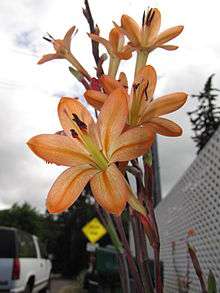Watsonia meriana
| Watsonia meriana | |
|---|---|
 | |
| Scientific classification | |
| Kingdom: | Plantae |
| (unranked): | Angiosperms |
| (unranked): | Monocots |
| Order: | Asparagales |
| Family: | Iridaceae |
| Subfamily: | Ixioideae |
| Tribe: | Watsonieae |
| Genus: | Watsonia |
| Species: | W. meriana |
| Binomial name | |
| Watsonia meriana (L.) Mill. | |
| Synonyms | |
|
Watsonia bulbillifera | |
Watsonia meriana is a species of flowering plant in the iris family (Iridaceae) known by the common name bulbil bugle-lily. It is one of several Watsonia species known as wild watsonia. It is native to the Cape Provinces of South Africa,[1] but it is well known as an ornamental plant grown in gardens for its showy spikes of flowers and an invasive species in areas where it has escaped cultivation. It is a perennial herb growing from a fibrous-coated corm and growing to a maximum height well over one meter when in flower, sometimes reaching two meters. Each corm produces three or four erect, lance-shaped leaves that measure up to 60 centimeters long by 6 wide. They have thickened midribs and margins. The inflorescence is an open spike of 8 to 25 flowers which may be any most any shade of orange to reddish or purplish. The flower is up to 8 centimeters long with a long, tubular throat and spreading tepals. The flowers sometimes yield capsule fruits which contain seed, but the plant often reproduces via bulbils (strictly speaking, cormlets) that form in clusters in the axils of bracts at nodes along the peduncle. The bulbils can sprout if dropped into the soil, sometimes forming dense colonies,[2] as can sections of corm that are chopped and dispersed by plowing or by non-intensive feeding by root-eating animals. The plant is accordingly ecologically valuable as feed to local mole-rats (Cryptomys and Georychus species) and to Cape porcupines (Hystrix africaeaustralis)
Like some other Watsonia, this species can take hold in the wild as a weedy introduced species in appropriate climates. It can be found along the southern coast of Australia, in New Zealand, and on the North Coast of California.[3][4][5] The plant forms dense colonies that crowd other plant species from the land where mole-rats, porcupines and similar herbivores do not occur.[6]
Cultivation
Hardiness: Zones 9-11[7]
References
- ↑ "Watsonia meriana". World Checklist of Selected Plant Families. Royal Botanic Gardens, Kew. Retrieved 2015-08-11.
- ↑ Manning, John (2008). Field Guide to Fynbos. Cape Town: Struik Publishers. ISBN 9781770072657.
- ↑ Weeds of Australia
- ↑ GRIN Species Profile
- ↑ Jepson Manual Treatment
- ↑ California IPC
- ↑ Learn2Grow